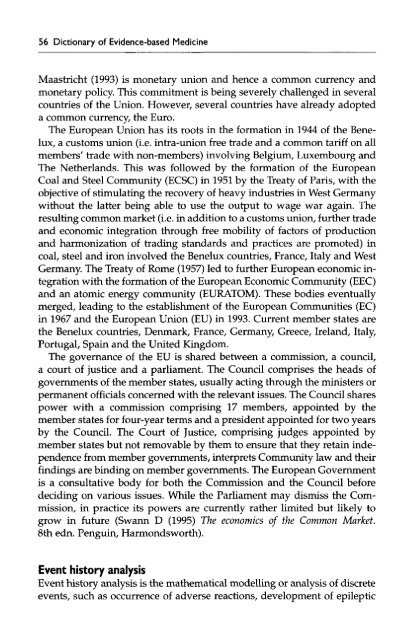Dictionary of Evidence-based Medicine.pdf
Dictionary of Evidence-based Medicine.pdf
Dictionary of Evidence-based Medicine.pdf
Create successful ePaper yourself
Turn your PDF publications into a flip-book with our unique Google optimized e-Paper software.
56 <strong>Dictionary</strong> <strong>of</strong> <strong>Evidence</strong>-<strong>based</strong> <strong>Medicine</strong><br />
Maastricht (1993) is monetary union and hence a common currency and<br />
monetary policy. This commitment is being severely challenged in several<br />
countries <strong>of</strong> the Union. However, several countries have already adopted<br />
a common currency, the Euro.<br />
The European Union has its roots in the formation in 1944 <strong>of</strong> the Benelux,<br />
a customs union (i.e. intra-union free trade and a common tariff on all<br />
members' trade with non-members) involving Belgium, Luxembourg and<br />
The Netherlands. This was followed by the formation <strong>of</strong> the European<br />
Coal and Steel Community (ECSC) in 1951 by the Treaty <strong>of</strong> Paris, with the<br />
objective <strong>of</strong> stimulating the recovery <strong>of</strong> heavy industries in West Germany<br />
without the latter being able to use the output to wage war again. The<br />
resulting common market (i.e. in addition to a customs union, further trade<br />
and economic integration through free mobility <strong>of</strong> factors <strong>of</strong> production<br />
and harmonization <strong>of</strong> trading standards and practices are promoted) in<br />
coal, steel and iron involved the Benelux countries, France, Italy and West<br />
Germany. The Treaty <strong>of</strong> Rome (1957) led to further European economic integration<br />
with the formation <strong>of</strong> the European Economic Community (EEC)<br />
and an atomic energy community (EURATOM). These bodies eventually<br />
merged, leading to the establishment <strong>of</strong> the European Communities (EC)<br />
in 1967 and the European Union (EU) in 1993. Current member states are<br />
the Benelux countries, Denmark, France, Germany, Greece, Ireland, Italy,<br />
Portugal, Spain and the United Kingdom.<br />
The governance <strong>of</strong> the EU is shared between a commission, a council,<br />
a court <strong>of</strong> justice and a parliament. The Council comprises the heads <strong>of</strong><br />
governments <strong>of</strong> the member states, usually acting through the ministers or<br />
permanent <strong>of</strong>ficials concerned with the relevant issues. The Council shares<br />
power with a commission comprising 17 members, appointed by the<br />
member states for four-year terms and a president appointed for two years<br />
by the Council. The Court <strong>of</strong> Justice, comprising judges appointed by<br />
member states but not removable by them to ensure that they retain independence<br />
from member governments, interprets Community law and their<br />
findings are binding on member governments. The European Government<br />
is a consultative body for both the Commission and the Council before<br />
deciding on various issues. While the Parliament may dismiss the Commission,<br />
in practice its powers are currently rather limited but likely to<br />
grow in future (Swarm D (1995) The economics <strong>of</strong> the Common Market.<br />
8th edn. Penguin, Harmondsworth).<br />
Event history analysis<br />
Event history analysis is the mathematical modelling or analysis <strong>of</strong> discrete<br />
events, such as occurrence <strong>of</strong> adverse reactions, development <strong>of</strong> epileptic










